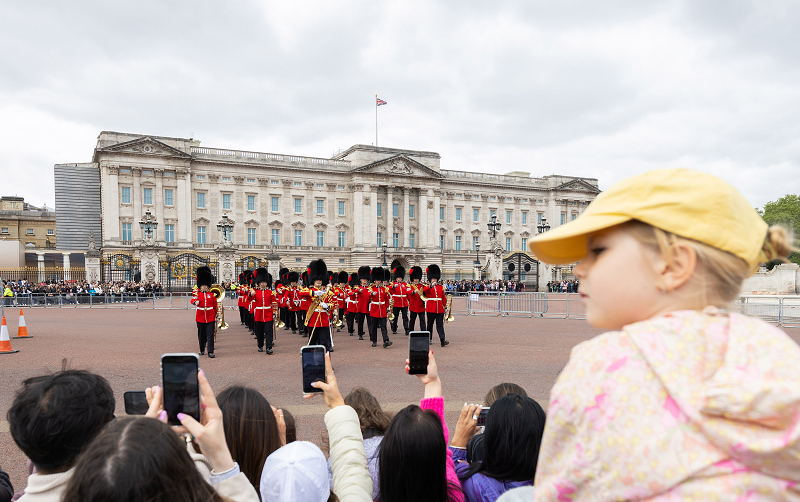ISABEL RUBIO ARROYO | Tungsteno
Famous historical figures such as Wolfgang Amadeus Mozart, Neil Armstrong and Nelson Mandela took centre stage at Buckingham Palace. Following the death of Queen Elizabeth II on 8 September, thousands of people gathered outside the historic building to bid her farewell after seven decades at the head of the British crown. We analyse the secrets of this iconic palace, which attracts more than 15 million tourists every year, and how it is managed.
A home with more than 700 rooms
King George III bought Buckingham Palace in 1761 and commissioned a renovation of the structure. In 1837 this historic building became the official residence of the British sovereigns in London. It also serves as the venue for many royal events and ceremonies, as stated by the British monarchy: "From entertaining foreign Heads of State to celebrating achievement at investitures and receptions".
The dimensions of this historic structure are overwhelming: 108 metres across the front, 120 metres deep and 24 metres high. Inside, it has 19 state rooms, 52 royal and guest bedrooms, 188 staff bedrooms, 92 offices and 78 bathrooms. But Buckingham Palace is much more than a home. It also has a cinema, an indoor swimming pool, a post office, a chapel, a doctor's surgery and even a cash machine.
Buckingham Palace has, in total, 775 bedrooms and 78 bathrooms. Credit: Good Morning Britain.
Maintaining a palace of this size requires a lot of time, money and staff. Today, more than 800 workers are employed at Buckingham Palace. Their jobs range from housekeeping and horticulture to catering and correspondence. In this large building, there are 1,514 doors and 760 windows. All windows are cleaned every six weeks. Among the more unusual jobs, there are two full-time clockmakers— the palace has more than 350 clocks—a fendersmith and a person to hoist and lower the flag.
From state banquets to royal weddings
More than 50,000 people visit the palace each year as guests at state banquets, luncheons, dinners, receptions and garden parties. Queen Elizabeth II also held weekly audiences with the Prime Minister and hosted newly appointed foreign ambassadors, charities, members of the Commonwealth and even athletes. The palace has also witnessed other important events, such as the birth of Prince Charles and Prince Andrew.
The balcony of Buckingham Palace is also one of the most famous in the world. The first recorded appearance on it was in 1851, when Queen Victoria stood there during the opening celebrations of the Great Exhibition. Elizabeth II has stood on the balcony at official annual birthday celebrations, as well as at special national events such as the 75th anniversary of the Battle of Britain and royal weddings.
Every year the British royals host banquets, receptions and garden parties at the palace. Credit: The Royal Family.
An accident-free and more sustainable palace
To keep the building in good condition and improve efficiency and accessibility, a 10-year renovation programme began in 2017. The Palace's electrical wiring, plumbing and heating had not been updated since the 1950s. More than 1,900 cables had exceeded their design life and more than 130 circuits were over 60 years old. "If these problems are not addressed, they will present a significant risk to the palace," an independent report said. Some work is necessary, according to the British monarchy, to avoid "a catastrophic failure involving fire or flood".
In 2018, the electrical installation was renovated. The workmen, who had to replace 6,500 sockets, found some century-old items under the floors of this building, which were probably discarded by Queen Victoria's courtiers in 1889. In addition to three packets of tobacco, they found a newspaper published days before the first jukebox was launched.
With this programme to renovate Buckingham Palace, the British monarchy aims to use more efficient technology to reduce the building's carbon footprint by 30%. "The palace currently produces 1,369 tonnes of carbon emissions per year," it says. Projected savings could bring this figure down to 815 tonnes. In theory, replacing the boilers alone will reduce energy consumption and the carbon footprint by around 10 percent.
At the palace, work is underway to remove old and potentially dangerous electrical wiring. Credit: The Royal Family.
With the death of Elizabeth II, her son Charles III, the UK's new monarch, is expected to move into the palace, according to Hugo Vickers, the acclaimed British biographer and royal expert. However, "King Charles will likely reside at Clarence House, at least for a while, given that Buckingham Palace is being extensively rewired". Jeremy Musson, chronicler of British country houses, suspects that this building "might be more economically used mostly for official functions and perhaps even more of it will be opened to the public, especially since the King is a stickler for streamlining the monarchy," he says. Time will tell whether Charles III finally opts to make this centrepiece of the UK's constitutional monarchy more accessible.
· — —
Tungsteno is a journalism laboratory to scan the essence of innovation. Devised by Materia Publicaciones Científicas for Sacyr’s blog.
